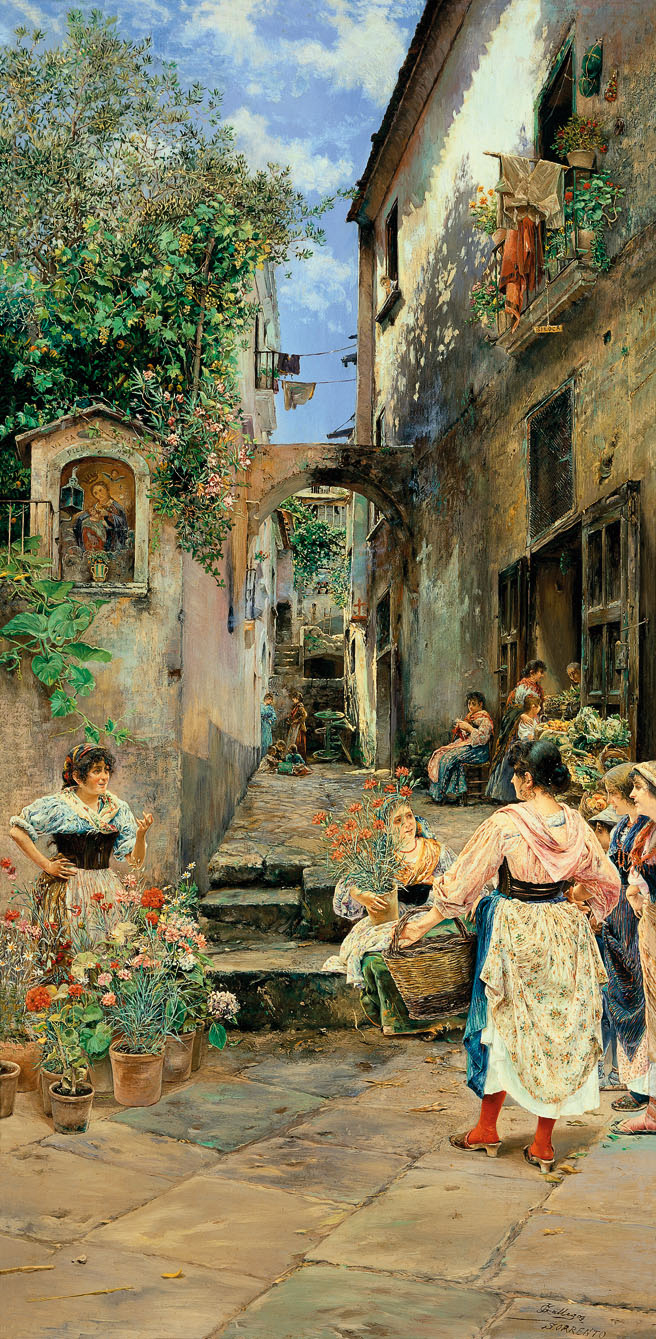
José Gallegos y Arnosa
Rumours
1893-
Oil on panel
55.3 x 27.2 cm
CTB.1997.17
-
© Colección Carmen Thyssen-Bornemisza en préstamo gratuito al Museo Carmen Thyssen Málaga
Standing out against the bright blue sky, a small vicolo in Sorrento serves as a stage for an anecdotal situation revolving totally around women. Surrounded by flowerpots with carnations, marguerites and other humble flowers set out for sale, a girl – protected by a typical Madonna street image – expressively addresses an attentive audience on a matter whose inconsequential content is referred to in the painting's title.
In port towns like Sorrento the sailors' wives eked out an existence during their husbands' absence by selling (or bartering) home-grown produce. But unlike the more socially committed painters of his generation, in dealing with this theme Gallegos Arnosa made not the slightest attempt either to dramatise or expose such situations. While the women in the foreground listen to the florist's story with murmurs of amusement, for those in the background life goes on in balanced, peaceful monotony, expressed in the painting through the geometrical harmony of the perspective, which contains women attending to their children and another woman knitting quietly in front of the door to a vegetable stall with a sign announcing rented accommodation – si loca – hanging from a string above it. High up in a window, another female listens with interest to the woman in the central scene below.
Here the Andalusian painter concentrated mainly on textures and tones, emphasising only their artistic values in imitation of Fortuny's précieux style. On the wall of the improvised boarding house, the shadows of the branches of the olive tree, oleanders, vines and other leafy fruit trees almost touching it are cast, again with tones obviously influenced by the Catalan master. The interplay of light and shadow continues to the end of the alley, where miniaturist brushstrokes form the small flowerpots and wooden ladder that are the most attractive part of the painting. The women's flowers are also interpreted with very tightly-controlled brushstrokes, while other details, such as the wet flagstones in the street or the old wood of the shutters, display a technical virtuosity that is somehow absent, however, in the general composition of the scene, since the main figures do not seem quite to fit in with their surroundings. Thus, in his own way Gallegos Arnosa, through vigorous, detailed, précieux descriptions, reveals himself both as a faithful follower of the highly successful style of art produced by Fortuny (whom he never met and whose pupil he could never have been, as Fortuny had died thirty years earlier) and a painter adept at keeping the memory of the Catalan master alive. As the inscription accompanying the signature reveals, Gallegos probably painted this picture during one of his visits to Naples, although he often worked on scenes and atmospheres without actually leaving his Rome studio. Furthermore, it is almost certain from a likeness in a photograph that the main figure in the scene – the girl spreading the rumour – is the famous actress Vittoria di Lepanto, who occasionally posed for the Via Margutta painters. When Gallegos Arnosa moved permanently to Rome in 1880, he actually spent less time painting than selling antiques, exhibiting them at his magnificent Rome studio, which consisted of three rooms of the Studi Patrizzi on that famous street in the Eternal City. The antiquarian Augusto Jandolo recalled how stunning it was to see the vast number of old objects in the Jerez artist's rooms (which explained the latter's interest in the merely material qualities of his painting and with which, in a way, he also evoked the legendary studio of the painter he longed to imitate): "Appena entrati, [in Gallegos's studio] si aveva l'impresione di trovarsi nella casa di un grande artista, benchè grandissimo artista egli non fosse."
Carlos G. Navarro